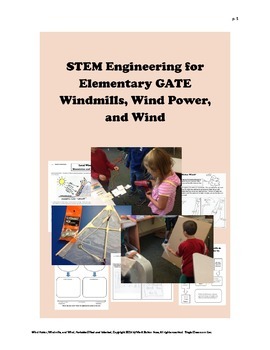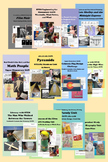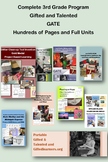STEM Engineering for Elementary GATE - Wind Power, Windmills, and Wind
Portable Gifted and Talented
3.1k Followers
Grade Levels
3rd - 6th
Subjects
Resource Type
Standards
CCSS3.MD.B.3
CCSS4.NF.B.3d
CCSSRI.4.1
CCSSRI.4.2
CCSSRI.4.3
Formats Included
- Word Document File
Pages
44 pages
Portable Gifted and Talented
3.1k Followers
Also included in
- All of it fresh and new and tried and kid-tested during the past school year—you are ready to rock and roll for 2016-17!Here you have over 350 pages and 75 hours of material—all with best practices in gifted and talented education.One stop. Huge discount over individual purchases: you save 47%. SPrice $29.99Original Price $54.91Save $24.92
- Everything you need to get you through a year of talent pools -- maybe more. It's all kid-tested in my own classroom. Highly engaging and challenging!My 3-4 and 4th grade Volume 1 bundles carry excellent reviews . . . but I think this bundle is even a little better as I have developed and enhancedPrice $26.99Original Price $44.42Save $17.43
Description
Two challenging but age-appropriate engineering projects highlight this unit. If you’ve taught my other STEM units, however, you know they’re not simply building projects. We’re thinking, learning science concepts, developing explanations, applying math and non-fiction reading skills, and bringing a wide variety of areas into a unit. But let’s not take lightly how cool it is to build and experiment with a cool mini glider and a working windmill!
As usual, we have ready-to-print activity sheets included to guide our thinking, plenty of pictures to go with the instructions for engineering projects, explanations and background, and Common Core State Standards references as well as Next Generation Science standards.
Gather some materials, and away you go!
Time: 8+ hours
Level: Gifted and Advanced 3rd and 4th; whole class 5th and 6th grade
Cost: A little over $1 per student (total for both projects combined), less if materials are purchased in bulk, and many items commonly found in the classroom.
What Makes Wind? Students respond to informational reading and show there understanding of what makes wind in a series of pictures.
Mini Gliders: Students construct mini gliders for an experiment (Note: I also have a full, separate unit in which we build the gliders and apply experiments and content to them.)
Upslope or Anabatic Flow: Students use their mini-gliders to experiment and observe, record their impressions, and reach conclusions. Students analyze an informative graphic and show their understanding in written responses.
Jet Stream: Students gather information through multiple means, make inferences about the language of science, construct a scaled representation of the information, and make more inferences about the jet stream winds.
Windmills: Students build working windmills, explain a process, and are invited to make calculations to solve a word problem with repeated addition of fractions.
Wind Turbines: Students compare the advantages and challenges of wind farms and then form an opinion.
As usual, we have ready-to-print activity sheets included to guide our thinking, plenty of pictures to go with the instructions for engineering projects, explanations and background, and Common Core State Standards references as well as Next Generation Science standards.
Gather some materials, and away you go!
Time: 8+ hours
Level: Gifted and Advanced 3rd and 4th; whole class 5th and 6th grade
Cost: A little over $1 per student (total for both projects combined), less if materials are purchased in bulk, and many items commonly found in the classroom.
What Makes Wind? Students respond to informational reading and show there understanding of what makes wind in a series of pictures.
Mini Gliders: Students construct mini gliders for an experiment (Note: I also have a full, separate unit in which we build the gliders and apply experiments and content to them.)
Upslope or Anabatic Flow: Students use their mini-gliders to experiment and observe, record their impressions, and reach conclusions. Students analyze an informative graphic and show their understanding in written responses.
Jet Stream: Students gather information through multiple means, make inferences about the language of science, construct a scaled representation of the information, and make more inferences about the jet stream winds.
Windmills: Students build working windmills, explain a process, and are invited to make calculations to solve a word problem with repeated addition of fractions.
Wind Turbines: Students compare the advantages and challenges of wind farms and then form an opinion.
Total Pages
44 pages
Answer Key
Included
Teaching Duration
Other
Last updated Oct 29th, 2015
Report this resource to TPT
Reported resources will be reviewed by our team. Report this resource to let us know if this resource violates TPT’s content guidelines.
Standards
to see state-specific standards (only available in the US).
CCSS3.MD.B.3
Draw a scaled picture graph and a scaled bar graph to represent a data set with several categories. Solve one- and two-step “how many more” and “how many less” problems using information presented in scaled bar graphs. For example, draw a bar graph in which each square in the bar graph might represent 5 pets.
CCSS4.NF.B.3d
Solve word problems involving addition and subtraction of fractions referring to the same whole and having like denominators, e.g., by using visual fraction models and equations to represent the problem.
CCSSRI.4.1
Refer to details and examples in a text when explaining what the text says explicitly and when drawing inferences from the text.
CCSSRI.4.2
Determine the main idea of a text and explain how it is supported by key details; summarize the text.
CCSSRI.4.3
Explain events, procedures, ideas, or concepts in a historical, scientific, or technical text, including what happened and why, based on specific information in the text.






